Psychological Perspectives in Understanding Human Development Report
VerifiedAdded on 2022/02/28
|14
|5674
|28
Report
AI Summary
This report provides an overview of two key psychological perspectives: the Behaviourist and Psychodynamic perspectives, and explores their implications for human development. The Behaviourist perspective, emphasizing environmental influences and observable behavior, is contrasted with the Psychodynamic perspective, which focuses on internal conflicts and the unconscious mind. The report also covers Social Learning Theory, building on the Behaviourist approach, and examines the application of these perspectives in health and social care contexts. Furthermore, the report discusses the impact of culture, economic factors (income, occupation, unemployment), and the physical environment (housing conditions) on human development. The document provides a detailed analysis of these factors, illustrating their influence on individuals' lives and well-being, and the importance of these factors in a person's social, emotional and intellectual development.
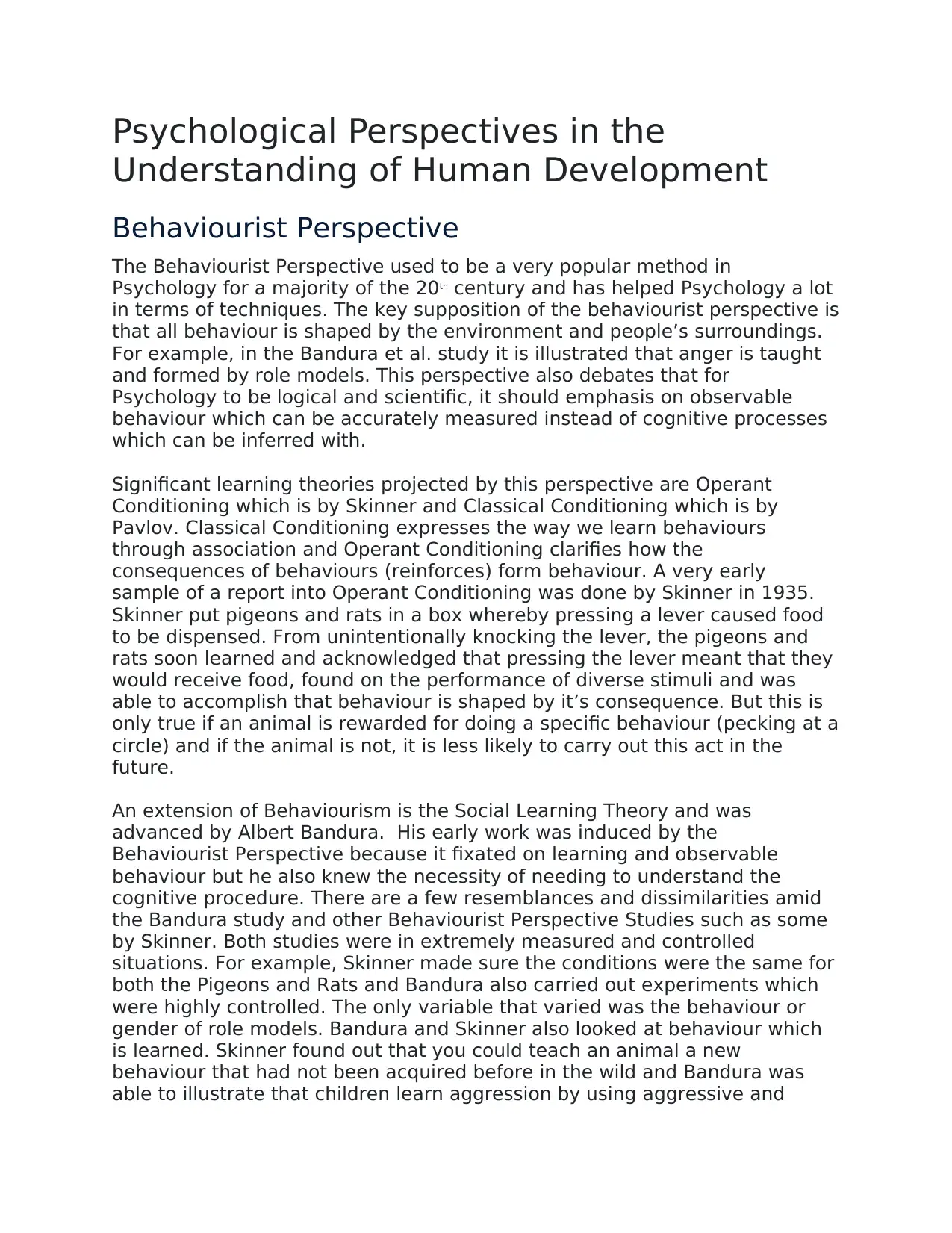
Psychological Perspectives in the
Understanding of Human Development
Behaviourist Perspective
The Behaviourist Perspective used to be a very popular method in
Psychology for a majority of the 20th century and has helped Psychology a lot
in terms of techniques. The key supposition of the behaviourist perspective is
that all behaviour is shaped by the environment and people’s surroundings.
For example, in the Bandura et al. study it is illustrated that anger is taught
and formed by role models. This perspective also debates that for
Psychology to be logical and scientific, it should emphasis on observable
behaviour which can be accurately measured instead of cognitive processes
which can be inferred with.
Significant learning theories projected by this perspective are Operant
Conditioning which is by Skinner and Classical Conditioning which is by
Pavlov. Classical Conditioning expresses the way we learn behaviours
through association and Operant Conditioning clarifies how the
consequences of behaviours (reinforces) form behaviour. A very early
sample of a report into Operant Conditioning was done by Skinner in 1935.
Skinner put pigeons and rats in a box whereby pressing a lever caused food
to be dispensed. From unintentionally knocking the lever, the pigeons and
rats soon learned and acknowledged that pressing the lever meant that they
would receive food, found on the performance of diverse stimuli and was
able to accomplish that behaviour is shaped by it’s consequence. But this is
only true if an animal is rewarded for doing a specific behaviour (pecking at a
circle) and if the animal is not, it is less likely to carry out this act in the
future.
An extension of Behaviourism is the Social Learning Theory and was
advanced by Albert Bandura. His early work was induced by the
Behaviourist Perspective because it fixated on learning and observable
behaviour but he also knew the necessity of needing to understand the
cognitive procedure. There are a few resemblances and dissimilarities amid
the Bandura study and other Behaviourist Perspective Studies such as some
by Skinner. Both studies were in extremely measured and controlled
situations. For example, Skinner made sure the conditions were the same for
both the Pigeons and Rats and Bandura also carried out experiments which
were highly controlled. The only variable that varied was the behaviour or
gender of role models. Bandura and Skinner also looked at behaviour which
is learned. Skinner found out that you could teach an animal a new
behaviour that had not been acquired before in the wild and Bandura was
able to illustrate that children learn aggression by using aggressive and
Understanding of Human Development
Behaviourist Perspective
The Behaviourist Perspective used to be a very popular method in
Psychology for a majority of the 20th century and has helped Psychology a lot
in terms of techniques. The key supposition of the behaviourist perspective is
that all behaviour is shaped by the environment and people’s surroundings.
For example, in the Bandura et al. study it is illustrated that anger is taught
and formed by role models. This perspective also debates that for
Psychology to be logical and scientific, it should emphasis on observable
behaviour which can be accurately measured instead of cognitive processes
which can be inferred with.
Significant learning theories projected by this perspective are Operant
Conditioning which is by Skinner and Classical Conditioning which is by
Pavlov. Classical Conditioning expresses the way we learn behaviours
through association and Operant Conditioning clarifies how the
consequences of behaviours (reinforces) form behaviour. A very early
sample of a report into Operant Conditioning was done by Skinner in 1935.
Skinner put pigeons and rats in a box whereby pressing a lever caused food
to be dispensed. From unintentionally knocking the lever, the pigeons and
rats soon learned and acknowledged that pressing the lever meant that they
would receive food, found on the performance of diverse stimuli and was
able to accomplish that behaviour is shaped by it’s consequence. But this is
only true if an animal is rewarded for doing a specific behaviour (pecking at a
circle) and if the animal is not, it is less likely to carry out this act in the
future.
An extension of Behaviourism is the Social Learning Theory and was
advanced by Albert Bandura. His early work was induced by the
Behaviourist Perspective because it fixated on learning and observable
behaviour but he also knew the necessity of needing to understand the
cognitive procedure. There are a few resemblances and dissimilarities amid
the Bandura study and other Behaviourist Perspective Studies such as some
by Skinner. Both studies were in extremely measured and controlled
situations. For example, Skinner made sure the conditions were the same for
both the Pigeons and Rats and Bandura also carried out experiments which
were highly controlled. The only variable that varied was the behaviour or
gender of role models. Bandura and Skinner also looked at behaviour which
is learned. Skinner found out that you could teach an animal a new
behaviour that had not been acquired before in the wild and Bandura was
able to illustrate that children learn aggression by using aggressive and
Paraphrase This Document
Need a fresh take? Get an instant paraphrase of this document with our AI Paraphraser
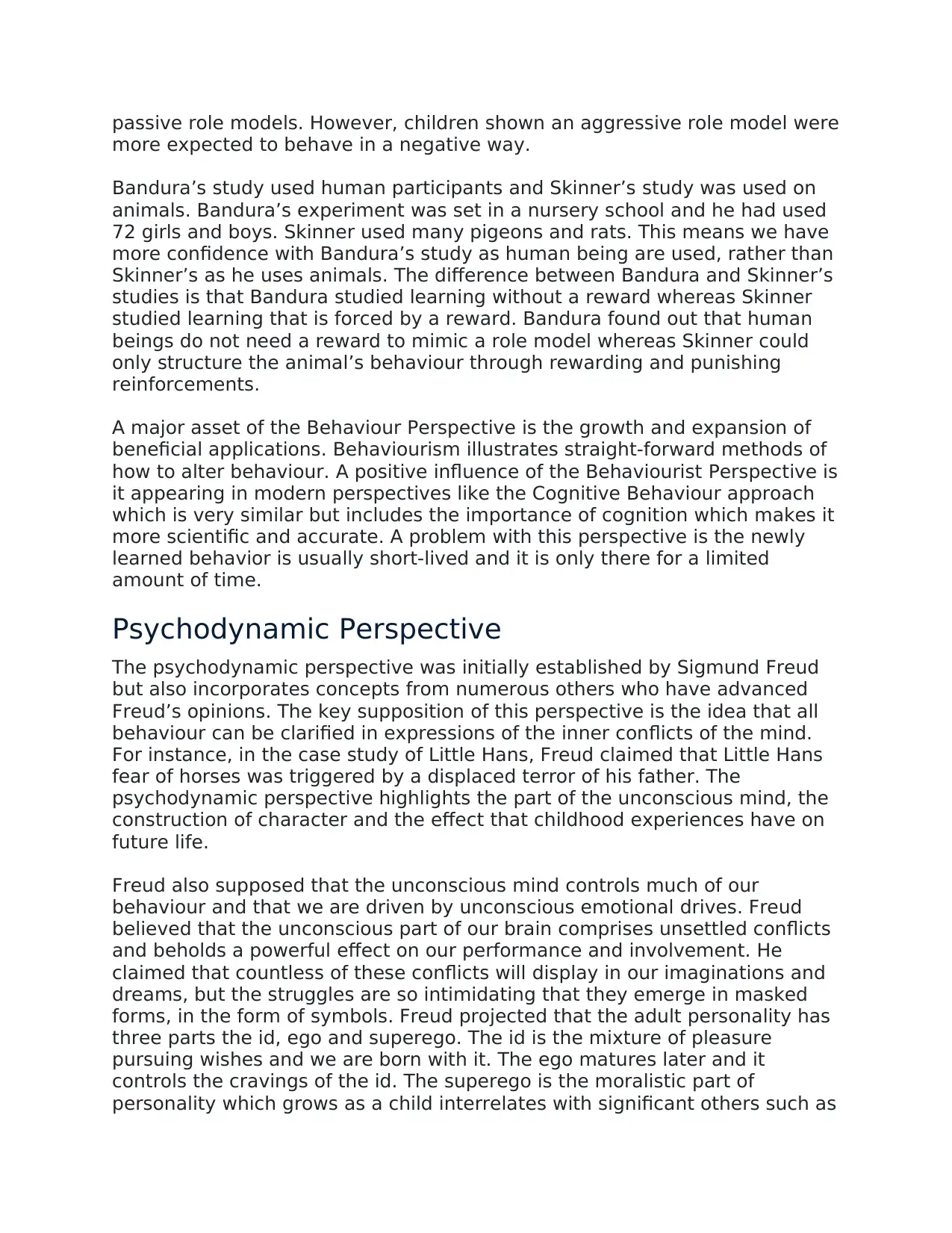
passive role models. However, children shown an aggressive role model were
more expected to behave in a negative way.
Bandura’s study used human participants and Skinner’s study was used on
animals. Bandura’s experiment was set in a nursery school and he had used
72 girls and boys. Skinner used many pigeons and rats. This means we have
more confidence with Bandura’s study as human being are used, rather than
Skinner’s as he uses animals. The difference between Bandura and Skinner’s
studies is that Bandura studied learning without a reward whereas Skinner
studied learning that is forced by a reward. Bandura found out that human
beings do not need a reward to mimic a role model whereas Skinner could
only structure the animal’s behaviour through rewarding and punishing
reinforcements.
A major asset of the Behaviour Perspective is the growth and expansion of
beneficial applications. Behaviourism illustrates straight-forward methods of
how to alter behaviour. A positive influence of the Behaviourist Perspective is
it appearing in modern perspectives like the Cognitive Behaviour approach
which is very similar but includes the importance of cognition which makes it
more scientific and accurate. A problem with this perspective is the newly
learned behavior is usually short-lived and it is only there for a limited
amount of time.
Psychodynamic Perspective
The psychodynamic perspective was initially established by Sigmund Freud
but also incorporates concepts from numerous others who have advanced
Freud’s opinions. The key supposition of this perspective is the idea that all
behaviour can be clarified in expressions of the inner conflicts of the mind.
For instance, in the case study of Little Hans, Freud claimed that Little Hans
fear of horses was triggered by a displaced terror of his father. The
psychodynamic perspective highlights the part of the unconscious mind, the
construction of character and the effect that childhood experiences have on
future life.
Freud also supposed that the unconscious mind controls much of our
behaviour and that we are driven by unconscious emotional drives. Freud
believed that the unconscious part of our brain comprises unsettled conflicts
and beholds a powerful effect on our performance and involvement. He
claimed that countless of these conflicts will display in our imaginations and
dreams, but the struggles are so intimidating that they emerge in masked
forms, in the form of symbols. Freud projected that the adult personality has
three parts the id, ego and superego. The id is the mixture of pleasure
pursuing wishes and we are born with it. The ego matures later and it
controls the cravings of the id. The superego is the moralistic part of
personality which grows as a child interrelates with significant others such as
more expected to behave in a negative way.
Bandura’s study used human participants and Skinner’s study was used on
animals. Bandura’s experiment was set in a nursery school and he had used
72 girls and boys. Skinner used many pigeons and rats. This means we have
more confidence with Bandura’s study as human being are used, rather than
Skinner’s as he uses animals. The difference between Bandura and Skinner’s
studies is that Bandura studied learning without a reward whereas Skinner
studied learning that is forced by a reward. Bandura found out that human
beings do not need a reward to mimic a role model whereas Skinner could
only structure the animal’s behaviour through rewarding and punishing
reinforcements.
A major asset of the Behaviour Perspective is the growth and expansion of
beneficial applications. Behaviourism illustrates straight-forward methods of
how to alter behaviour. A positive influence of the Behaviourist Perspective is
it appearing in modern perspectives like the Cognitive Behaviour approach
which is very similar but includes the importance of cognition which makes it
more scientific and accurate. A problem with this perspective is the newly
learned behavior is usually short-lived and it is only there for a limited
amount of time.
Psychodynamic Perspective
The psychodynamic perspective was initially established by Sigmund Freud
but also incorporates concepts from numerous others who have advanced
Freud’s opinions. The key supposition of this perspective is the idea that all
behaviour can be clarified in expressions of the inner conflicts of the mind.
For instance, in the case study of Little Hans, Freud claimed that Little Hans
fear of horses was triggered by a displaced terror of his father. The
psychodynamic perspective highlights the part of the unconscious mind, the
construction of character and the effect that childhood experiences have on
future life.
Freud also supposed that the unconscious mind controls much of our
behaviour and that we are driven by unconscious emotional drives. Freud
believed that the unconscious part of our brain comprises unsettled conflicts
and beholds a powerful effect on our performance and involvement. He
claimed that countless of these conflicts will display in our imaginations and
dreams, but the struggles are so intimidating that they emerge in masked
forms, in the form of symbols. Freud projected that the adult personality has
three parts the id, ego and superego. The id is the mixture of pleasure
pursuing wishes and we are born with it. The ego matures later and it
controls the cravings of the id. The superego is the moralistic part of
personality which grows as a child interrelates with significant others such as
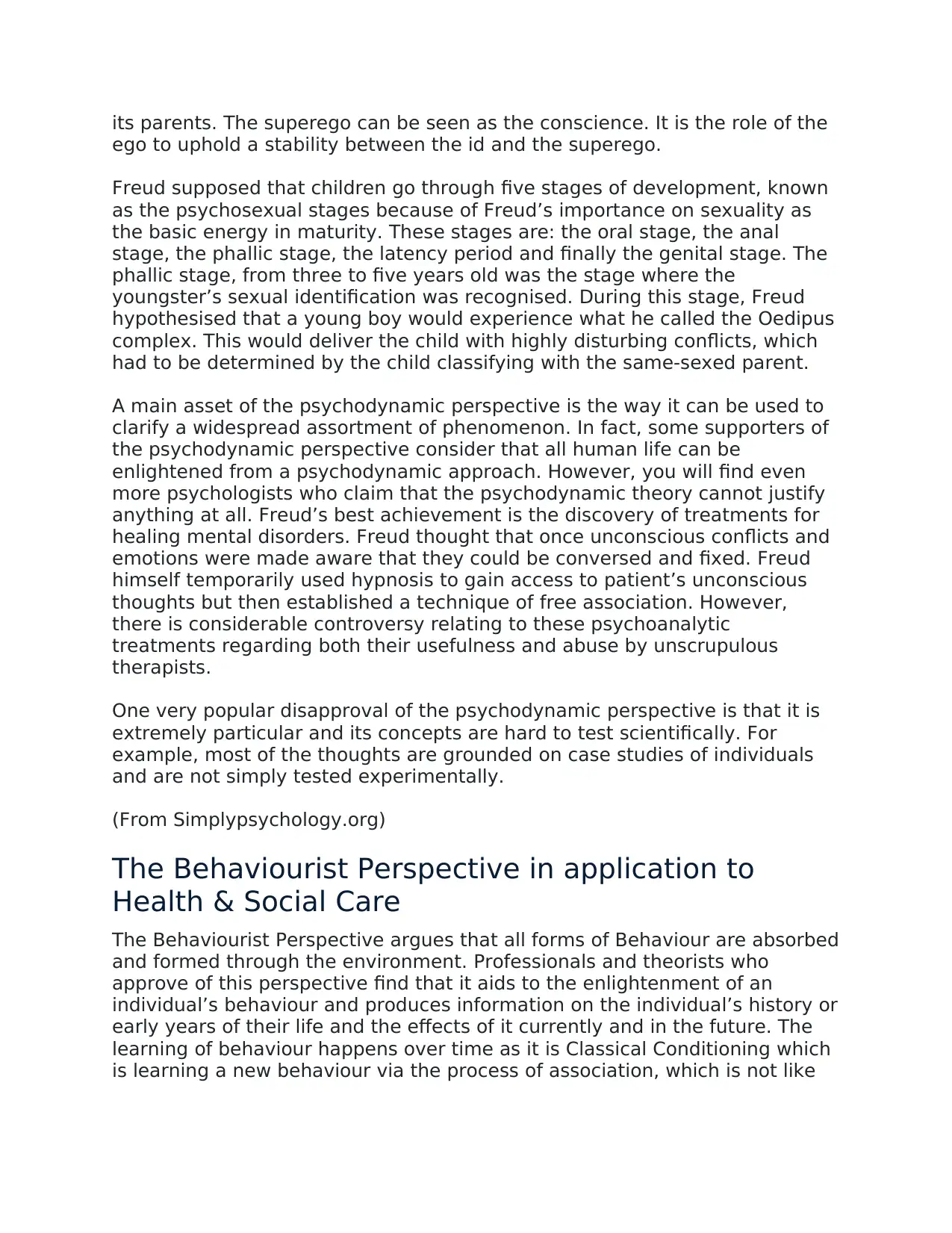
its parents. The superego can be seen as the conscience. It is the role of the
ego to uphold a stability between the id and the superego.
Freud supposed that children go through five stages of development, known
as the psychosexual stages because of Freud’s importance on sexuality as
the basic energy in maturity. These stages are: the oral stage, the anal
stage, the phallic stage, the latency period and finally the genital stage. The
phallic stage, from three to five years old was the stage where the
youngster’s sexual identification was recognised. During this stage, Freud
hypothesised that a young boy would experience what he called the Oedipus
complex. This would deliver the child with highly disturbing conflicts, which
had to be determined by the child classifying with the same-sexed parent.
A main asset of the psychodynamic perspective is the way it can be used to
clarify a widespread assortment of phenomenon. In fact, some supporters of
the psychodynamic perspective consider that all human life can be
enlightened from a psychodynamic approach. However, you will find even
more psychologists who claim that the psychodynamic theory cannot justify
anything at all. Freud’s best achievement is the discovery of treatments for
healing mental disorders. Freud thought that once unconscious conflicts and
emotions were made aware that they could be conversed and fixed. Freud
himself temporarily used hypnosis to gain access to patient’s unconscious
thoughts but then established a technique of free association. However,
there is considerable controversy relating to these psychoanalytic
treatments regarding both their usefulness and abuse by unscrupulous
therapists.
One very popular disapproval of the psychodynamic perspective is that it is
extremely particular and its concepts are hard to test scientifically. For
example, most of the thoughts are grounded on case studies of individuals
and are not simply tested experimentally.
(From Simplypsychology.org)
The Behaviourist Perspective in application to
Health & Social Care
The Behaviourist Perspective argues that all forms of Behaviour are absorbed
and formed through the environment. Professionals and theorists who
approve of this perspective find that it aids to the enlightenment of an
individual’s behaviour and produces information on the individual’s history or
early years of their life and the effects of it currently and in the future. The
learning of behaviour happens over time as it is Classical Conditioning which
is learning a new behaviour via the process of association, which is not like
ego to uphold a stability between the id and the superego.
Freud supposed that children go through five stages of development, known
as the psychosexual stages because of Freud’s importance on sexuality as
the basic energy in maturity. These stages are: the oral stage, the anal
stage, the phallic stage, the latency period and finally the genital stage. The
phallic stage, from three to five years old was the stage where the
youngster’s sexual identification was recognised. During this stage, Freud
hypothesised that a young boy would experience what he called the Oedipus
complex. This would deliver the child with highly disturbing conflicts, which
had to be determined by the child classifying with the same-sexed parent.
A main asset of the psychodynamic perspective is the way it can be used to
clarify a widespread assortment of phenomenon. In fact, some supporters of
the psychodynamic perspective consider that all human life can be
enlightened from a psychodynamic approach. However, you will find even
more psychologists who claim that the psychodynamic theory cannot justify
anything at all. Freud’s best achievement is the discovery of treatments for
healing mental disorders. Freud thought that once unconscious conflicts and
emotions were made aware that they could be conversed and fixed. Freud
himself temporarily used hypnosis to gain access to patient’s unconscious
thoughts but then established a technique of free association. However,
there is considerable controversy relating to these psychoanalytic
treatments regarding both their usefulness and abuse by unscrupulous
therapists.
One very popular disapproval of the psychodynamic perspective is that it is
extremely particular and its concepts are hard to test scientifically. For
example, most of the thoughts are grounded on case studies of individuals
and are not simply tested experimentally.
(From Simplypsychology.org)
The Behaviourist Perspective in application to
Health & Social Care
The Behaviourist Perspective argues that all forms of Behaviour are absorbed
and formed through the environment. Professionals and theorists who
approve of this perspective find that it aids to the enlightenment of an
individual’s behaviour and produces information on the individual’s history or
early years of their life and the effects of it currently and in the future. The
learning of behaviour happens over time as it is Classical Conditioning which
is learning a new behaviour via the process of association, which is not like
⊘ This is a preview!⊘
Do you want full access?
Subscribe today to unlock all pages.

Trusted by 1+ million students worldwide
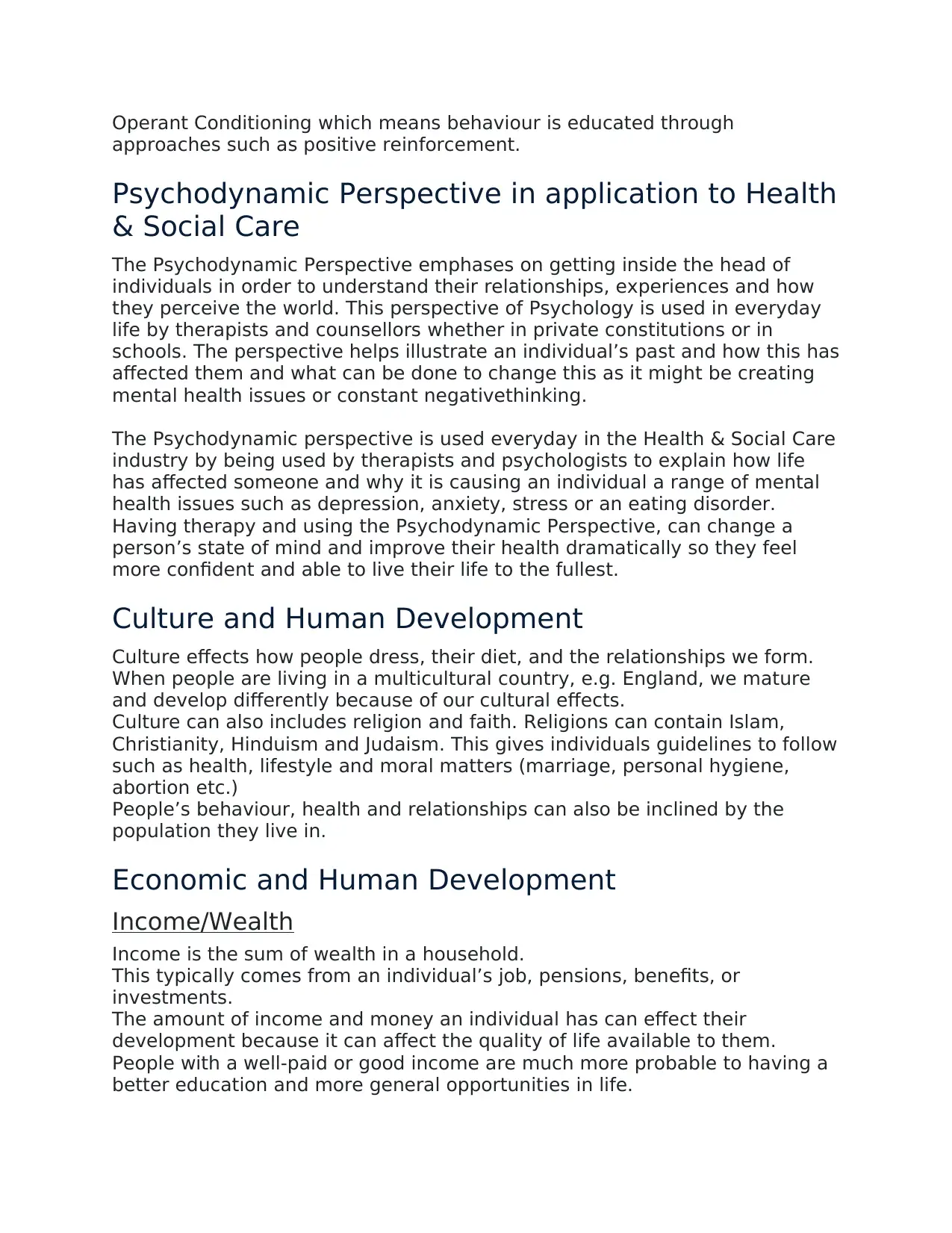
Operant Conditioning which means behaviour is educated through
approaches such as positive reinforcement.
Psychodynamic Perspective in application to Health
& Social Care
The Psychodynamic Perspective emphases on getting inside the head of
individuals in order to understand their relationships, experiences and how
they perceive the world. This perspective of Psychology is used in everyday
life by therapists and counsellors whether in private constitutions or in
schools. The perspective helps illustrate an individual’s past and how this has
affected them and what can be done to change this as it might be creating
mental health issues or constant negativethinking.
The Psychodynamic perspective is used everyday in the Health & Social Care
industry by being used by therapists and psychologists to explain how life
has affected someone and why it is causing an individual a range of mental
health issues such as depression, anxiety, stress or an eating disorder.
Having therapy and using the Psychodynamic Perspective, can change a
person’s state of mind and improve their health dramatically so they feel
more confident and able to live their life to the fullest.
Culture and Human Development
Culture effects how people dress, their diet, and the relationships we form.
When people are living in a multicultural country, e.g. England, we mature
and develop differently because of our cultural effects.
Culture can also includes religion and faith. Religions can contain Islam,
Christianity, Hinduism and Judaism. This gives individuals guidelines to follow
such as health, lifestyle and moral matters (marriage, personal hygiene,
abortion etc.)
People’s behaviour, health and relationships can also be inclined by the
population they live in.
Economic and Human Development
Income/Wealth
Income is the sum of wealth in a household.
This typically comes from an individual’s job, pensions, benefits, or
investments.
The amount of income and money an individual has can effect their
development because it can affect the quality of life available to them.
People with a well-paid or good income are much more probable to having a
better education and more general opportunities in life.
approaches such as positive reinforcement.
Psychodynamic Perspective in application to Health
& Social Care
The Psychodynamic Perspective emphases on getting inside the head of
individuals in order to understand their relationships, experiences and how
they perceive the world. This perspective of Psychology is used in everyday
life by therapists and counsellors whether in private constitutions or in
schools. The perspective helps illustrate an individual’s past and how this has
affected them and what can be done to change this as it might be creating
mental health issues or constant negativethinking.
The Psychodynamic perspective is used everyday in the Health & Social Care
industry by being used by therapists and psychologists to explain how life
has affected someone and why it is causing an individual a range of mental
health issues such as depression, anxiety, stress or an eating disorder.
Having therapy and using the Psychodynamic Perspective, can change a
person’s state of mind and improve their health dramatically so they feel
more confident and able to live their life to the fullest.
Culture and Human Development
Culture effects how people dress, their diet, and the relationships we form.
When people are living in a multicultural country, e.g. England, we mature
and develop differently because of our cultural effects.
Culture can also includes religion and faith. Religions can contain Islam,
Christianity, Hinduism and Judaism. This gives individuals guidelines to follow
such as health, lifestyle and moral matters (marriage, personal hygiene,
abortion etc.)
People’s behaviour, health and relationships can also be inclined by the
population they live in.
Economic and Human Development
Income/Wealth
Income is the sum of wealth in a household.
This typically comes from an individual’s job, pensions, benefits, or
investments.
The amount of income and money an individual has can effect their
development because it can affect the quality of life available to them.
People with a well-paid or good income are much more probable to having a
better education and more general opportunities in life.
Paraphrase This Document
Need a fresh take? Get an instant paraphrase of this document with our AI Paraphraser
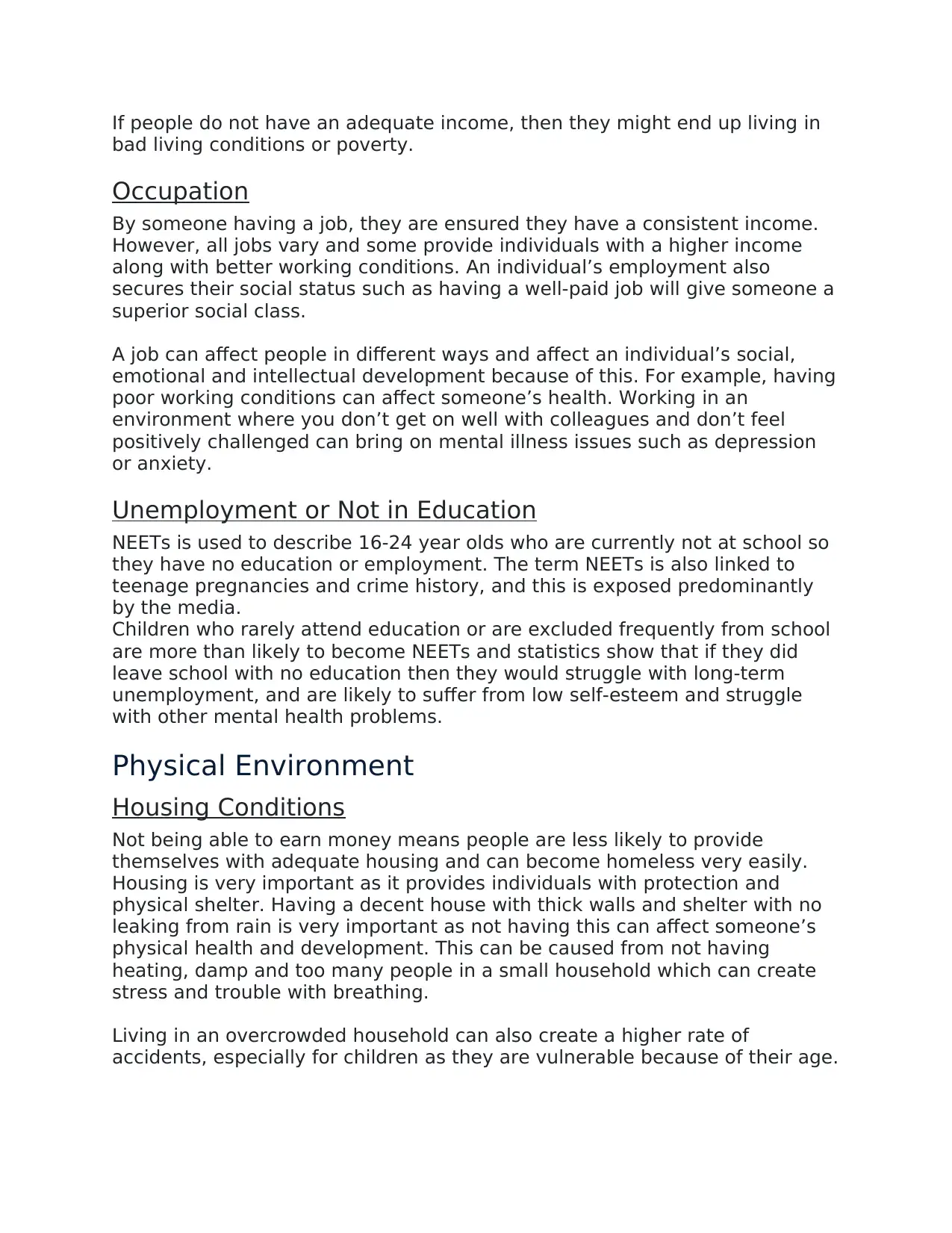
If people do not have an adequate income, then they might end up living in
bad living conditions or poverty.
Occupation
By someone having a job, they are ensured they have a consistent income.
However, all jobs vary and some provide individuals with a higher income
along with better working conditions. An individual’s employment also
secures their social status such as having a well-paid job will give someone a
superior social class.
A job can affect people in different ways and affect an individual’s social,
emotional and intellectual development because of this. For example, having
poor working conditions can affect someone’s health. Working in an
environment where you don’t get on well with colleagues and don’t feel
positively challenged can bring on mental illness issues such as depression
or anxiety.
Unemployment or Not in Education
NEETs is used to describe 16-24 year olds who are currently not at school so
they have no education or employment. The term NEETs is also linked to
teenage pregnancies and crime history, and this is exposed predominantly
by the media.
Children who rarely attend education or are excluded frequently from school
are more than likely to become NEETs and statistics show that if they did
leave school with no education then they would struggle with long-term
unemployment, and are likely to suffer from low self-esteem and struggle
with other mental health problems.
Physical Environment
Housing Conditions
Not being able to earn money means people are less likely to provide
themselves with adequate housing and can become homeless very easily.
Housing is very important as it provides individuals with protection and
physical shelter. Having a decent house with thick walls and shelter with no
leaking from rain is very important as not having this can affect someone’s
physical health and development. This can be caused from not having
heating, damp and too many people in a small household which can create
stress and trouble with breathing.
Living in an overcrowded household can also create a higher rate of
accidents, especially for children as they are vulnerable because of their age.
bad living conditions or poverty.
Occupation
By someone having a job, they are ensured they have a consistent income.
However, all jobs vary and some provide individuals with a higher income
along with better working conditions. An individual’s employment also
secures their social status such as having a well-paid job will give someone a
superior social class.
A job can affect people in different ways and affect an individual’s social,
emotional and intellectual development because of this. For example, having
poor working conditions can affect someone’s health. Working in an
environment where you don’t get on well with colleagues and don’t feel
positively challenged can bring on mental illness issues such as depression
or anxiety.
Unemployment or Not in Education
NEETs is used to describe 16-24 year olds who are currently not at school so
they have no education or employment. The term NEETs is also linked to
teenage pregnancies and crime history, and this is exposed predominantly
by the media.
Children who rarely attend education or are excluded frequently from school
are more than likely to become NEETs and statistics show that if they did
leave school with no education then they would struggle with long-term
unemployment, and are likely to suffer from low self-esteem and struggle
with other mental health problems.
Physical Environment
Housing Conditions
Not being able to earn money means people are less likely to provide
themselves with adequate housing and can become homeless very easily.
Housing is very important as it provides individuals with protection and
physical shelter. Having a decent house with thick walls and shelter with no
leaking from rain is very important as not having this can affect someone’s
physical health and development. This can be caused from not having
heating, damp and too many people in a small household which can create
stress and trouble with breathing.
Living in an overcrowded household can also create a higher rate of
accidents, especially for children as they are vulnerable because of their age.
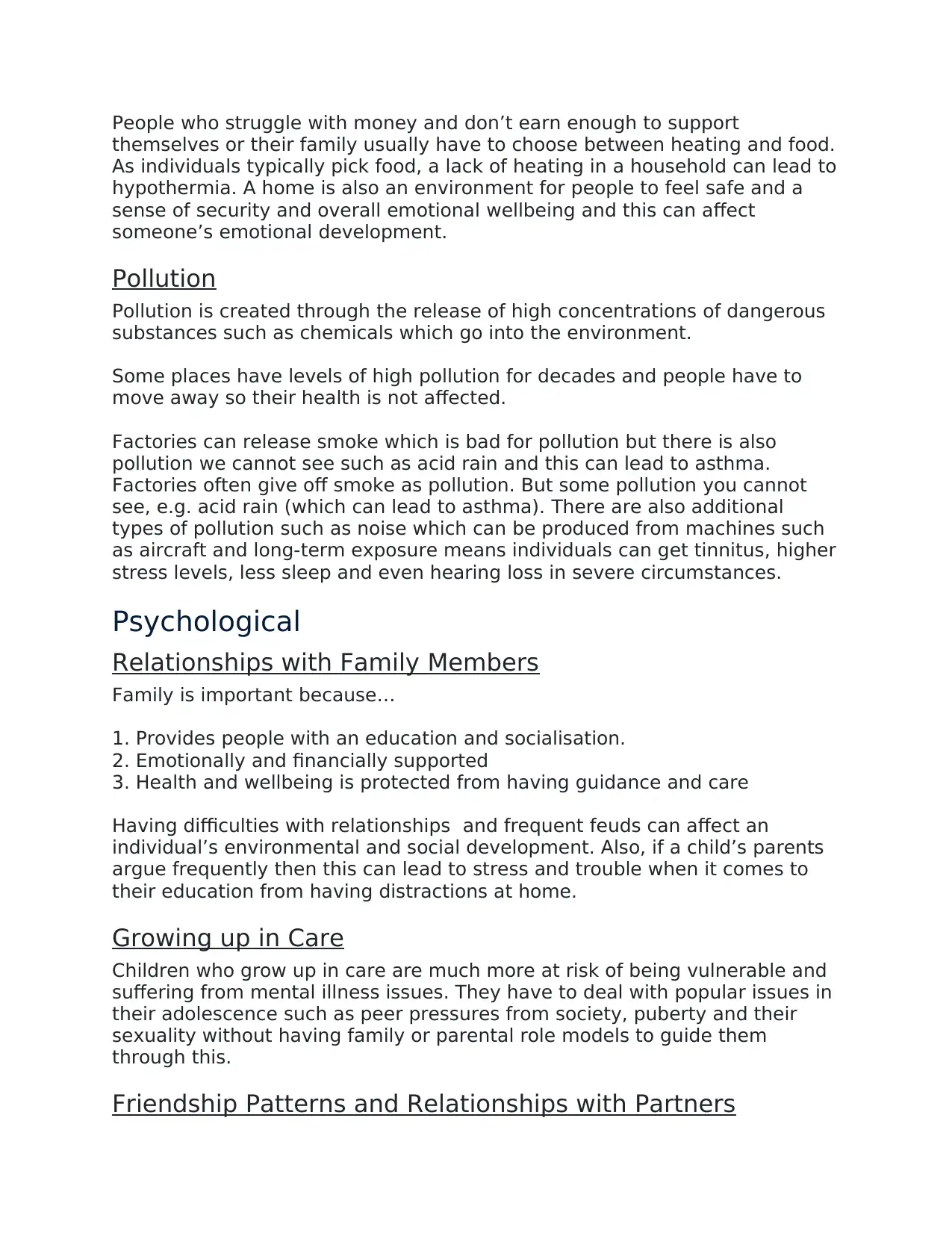
People who struggle with money and don’t earn enough to support
themselves or their family usually have to choose between heating and food.
As individuals typically pick food, a lack of heating in a household can lead to
hypothermia. A home is also an environment for people to feel safe and a
sense of security and overall emotional wellbeing and this can affect
someone’s emotional development.
Pollution
Pollution is created through the release of high concentrations of dangerous
substances such as chemicals which go into the environment.
Some places have levels of high pollution for decades and people have to
move away so their health is not affected.
Factories can release smoke which is bad for pollution but there is also
pollution we cannot see such as acid rain and this can lead to asthma.
Factories often give off smoke as pollution. But some pollution you cannot
see, e.g. acid rain (which can lead to asthma). There are also additional
types of pollution such as noise which can be produced from machines such
as aircraft and long-term exposure means individuals can get tinnitus, higher
stress levels, less sleep and even hearing loss in severe circumstances.
Psychological
Relationships with Family Members
Family is important because…
1. Provides people with an education and socialisation.
2. Emotionally and financially supported
3. Health and wellbeing is protected from having guidance and care
Having difficulties with relationships and frequent feuds can affect an
individual’s environmental and social development. Also, if a child’s parents
argue frequently then this can lead to stress and trouble when it comes to
their education from having distractions at home.
Growing up in Care
Children who grow up in care are much more at risk of being vulnerable and
suffering from mental illness issues. They have to deal with popular issues in
their adolescence such as peer pressures from society, puberty and their
sexuality without having family or parental role models to guide them
through this.
Friendship Patterns and Relationships with Partners
themselves or their family usually have to choose between heating and food.
As individuals typically pick food, a lack of heating in a household can lead to
hypothermia. A home is also an environment for people to feel safe and a
sense of security and overall emotional wellbeing and this can affect
someone’s emotional development.
Pollution
Pollution is created through the release of high concentrations of dangerous
substances such as chemicals which go into the environment.
Some places have levels of high pollution for decades and people have to
move away so their health is not affected.
Factories can release smoke which is bad for pollution but there is also
pollution we cannot see such as acid rain and this can lead to asthma.
Factories often give off smoke as pollution. But some pollution you cannot
see, e.g. acid rain (which can lead to asthma). There are also additional
types of pollution such as noise which can be produced from machines such
as aircraft and long-term exposure means individuals can get tinnitus, higher
stress levels, less sleep and even hearing loss in severe circumstances.
Psychological
Relationships with Family Members
Family is important because…
1. Provides people with an education and socialisation.
2. Emotionally and financially supported
3. Health and wellbeing is protected from having guidance and care
Having difficulties with relationships and frequent feuds can affect an
individual’s environmental and social development. Also, if a child’s parents
argue frequently then this can lead to stress and trouble when it comes to
their education from having distractions at home.
Growing up in Care
Children who grow up in care are much more at risk of being vulnerable and
suffering from mental illness issues. They have to deal with popular issues in
their adolescence such as peer pressures from society, puberty and their
sexuality without having family or parental role models to guide them
through this.
Friendship Patterns and Relationships with Partners
⊘ This is a preview!⊘
Do you want full access?
Subscribe today to unlock all pages.

Trusted by 1+ million students worldwide
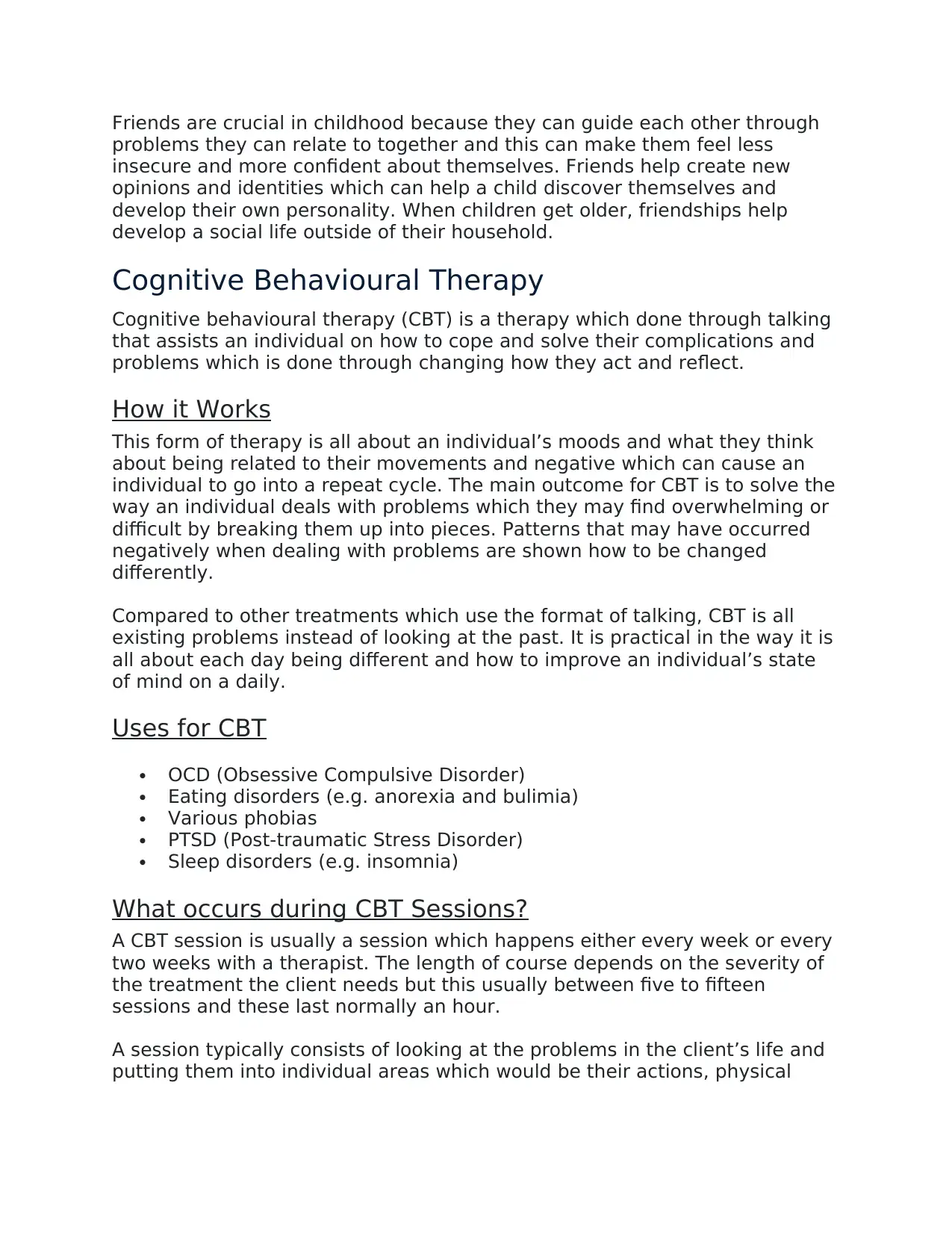
Friends are crucial in childhood because they can guide each other through
problems they can relate to together and this can make them feel less
insecure and more confident about themselves. Friends help create new
opinions and identities which can help a child discover themselves and
develop their own personality. When children get older, friendships help
develop a social life outside of their household.
Cognitive Behavioural Therapy
Cognitive behavioural therapy (CBT) is a therapy which done through talking
that assists an individual on how to cope and solve their complications and
problems which is done through changing how they act and reflect.
How it Works
This form of therapy is all about an individual’s moods and what they think
about being related to their movements and negative which can cause an
individual to go into a repeat cycle. The main outcome for CBT is to solve the
way an individual deals with problems which they may find overwhelming or
difficult by breaking them up into pieces. Patterns that may have occurred
negatively when dealing with problems are shown how to be changed
differently.
Compared to other treatments which use the format of talking, CBT is all
existing problems instead of looking at the past. It is practical in the way it is
all about each day being different and how to improve an individual’s state
of mind on a daily.
Uses for CBT
OCD (Obsessive Compulsive Disorder)
Eating disorders (e.g. anorexia and bulimia)
Various phobias
PTSD (Post-traumatic Stress Disorder)
Sleep disorders (e.g. insomnia)
What occurs during CBT Sessions?
A CBT session is usually a session which happens either every week or every
two weeks with a therapist. The length of course depends on the severity of
the treatment the client needs but this usually between five to fifteen
sessions and these last normally an hour.
A session typically consists of looking at the problems in the client’s life and
putting them into individual areas which would be their actions, physical
problems they can relate to together and this can make them feel less
insecure and more confident about themselves. Friends help create new
opinions and identities which can help a child discover themselves and
develop their own personality. When children get older, friendships help
develop a social life outside of their household.
Cognitive Behavioural Therapy
Cognitive behavioural therapy (CBT) is a therapy which done through talking
that assists an individual on how to cope and solve their complications and
problems which is done through changing how they act and reflect.
How it Works
This form of therapy is all about an individual’s moods and what they think
about being related to their movements and negative which can cause an
individual to go into a repeat cycle. The main outcome for CBT is to solve the
way an individual deals with problems which they may find overwhelming or
difficult by breaking them up into pieces. Patterns that may have occurred
negatively when dealing with problems are shown how to be changed
differently.
Compared to other treatments which use the format of talking, CBT is all
existing problems instead of looking at the past. It is practical in the way it is
all about each day being different and how to improve an individual’s state
of mind on a daily.
Uses for CBT
OCD (Obsessive Compulsive Disorder)
Eating disorders (e.g. anorexia and bulimia)
Various phobias
PTSD (Post-traumatic Stress Disorder)
Sleep disorders (e.g. insomnia)
What occurs during CBT Sessions?
A CBT session is usually a session which happens either every week or every
two weeks with a therapist. The length of course depends on the severity of
the treatment the client needs but this usually between five to fifteen
sessions and these last normally an hour.
A session typically consists of looking at the problems in the client’s life and
putting them into individual areas which would be their actions, physical
Paraphrase This Document
Need a fresh take? Get an instant paraphrase of this document with our AI Paraphraser
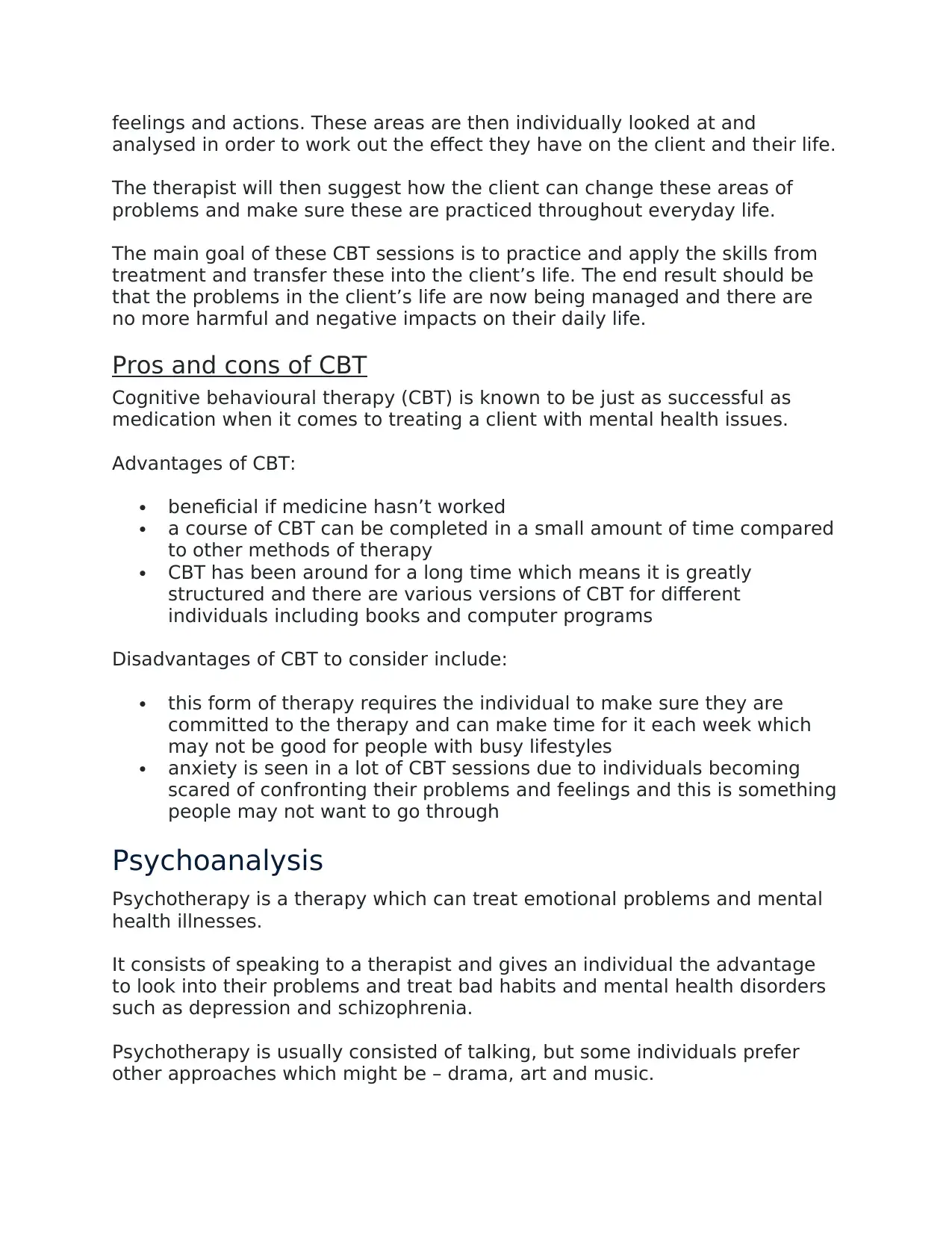
feelings and actions. These areas are then individually looked at and
analysed in order to work out the effect they have on the client and their life.
The therapist will then suggest how the client can change these areas of
problems and make sure these are practiced throughout everyday life.
The main goal of these CBT sessions is to practice and apply the skills from
treatment and transfer these into the client’s life. The end result should be
that the problems in the client’s life are now being managed and there are
no more harmful and negative impacts on their daily life.
Pros and cons of CBT
Cognitive behavioural therapy (CBT) is known to be just as successful as
medication when it comes to treating a client with mental health issues.
Advantages of CBT:
beneficial if medicine hasn’t worked
a course of CBT can be completed in a small amount of time compared
to other methods of therapy
CBT has been around for a long time which means it is greatly
structured and there are various versions of CBT for different
individuals including books and computer programs
Disadvantages of CBT to consider include:
this form of therapy requires the individual to make sure they are
committed to the therapy and can make time for it each week which
may not be good for people with busy lifestyles
anxiety is seen in a lot of CBT sessions due to individuals becoming
scared of confronting their problems and feelings and this is something
people may not want to go through
Psychoanalysis
Psychotherapy is a therapy which can treat emotional problems and mental
health illnesses.
It consists of speaking to a therapist and gives an individual the advantage
to look into their problems and treat bad habits and mental health disorders
such as depression and schizophrenia.
Psychotherapy is usually consisted of talking, but some individuals prefer
other approaches which might be – drama, art and music.
analysed in order to work out the effect they have on the client and their life.
The therapist will then suggest how the client can change these areas of
problems and make sure these are practiced throughout everyday life.
The main goal of these CBT sessions is to practice and apply the skills from
treatment and transfer these into the client’s life. The end result should be
that the problems in the client’s life are now being managed and there are
no more harmful and negative impacts on their daily life.
Pros and cons of CBT
Cognitive behavioural therapy (CBT) is known to be just as successful as
medication when it comes to treating a client with mental health issues.
Advantages of CBT:
beneficial if medicine hasn’t worked
a course of CBT can be completed in a small amount of time compared
to other methods of therapy
CBT has been around for a long time which means it is greatly
structured and there are various versions of CBT for different
individuals including books and computer programs
Disadvantages of CBT to consider include:
this form of therapy requires the individual to make sure they are
committed to the therapy and can make time for it each week which
may not be good for people with busy lifestyles
anxiety is seen in a lot of CBT sessions due to individuals becoming
scared of confronting their problems and feelings and this is something
people may not want to go through
Psychoanalysis
Psychotherapy is a therapy which can treat emotional problems and mental
health illnesses.
It consists of speaking to a therapist and gives an individual the advantage
to look into their problems and treat bad habits and mental health disorders
such as depression and schizophrenia.
Psychotherapy is usually consisted of talking, but some individuals prefer
other approaches which might be – drama, art and music.
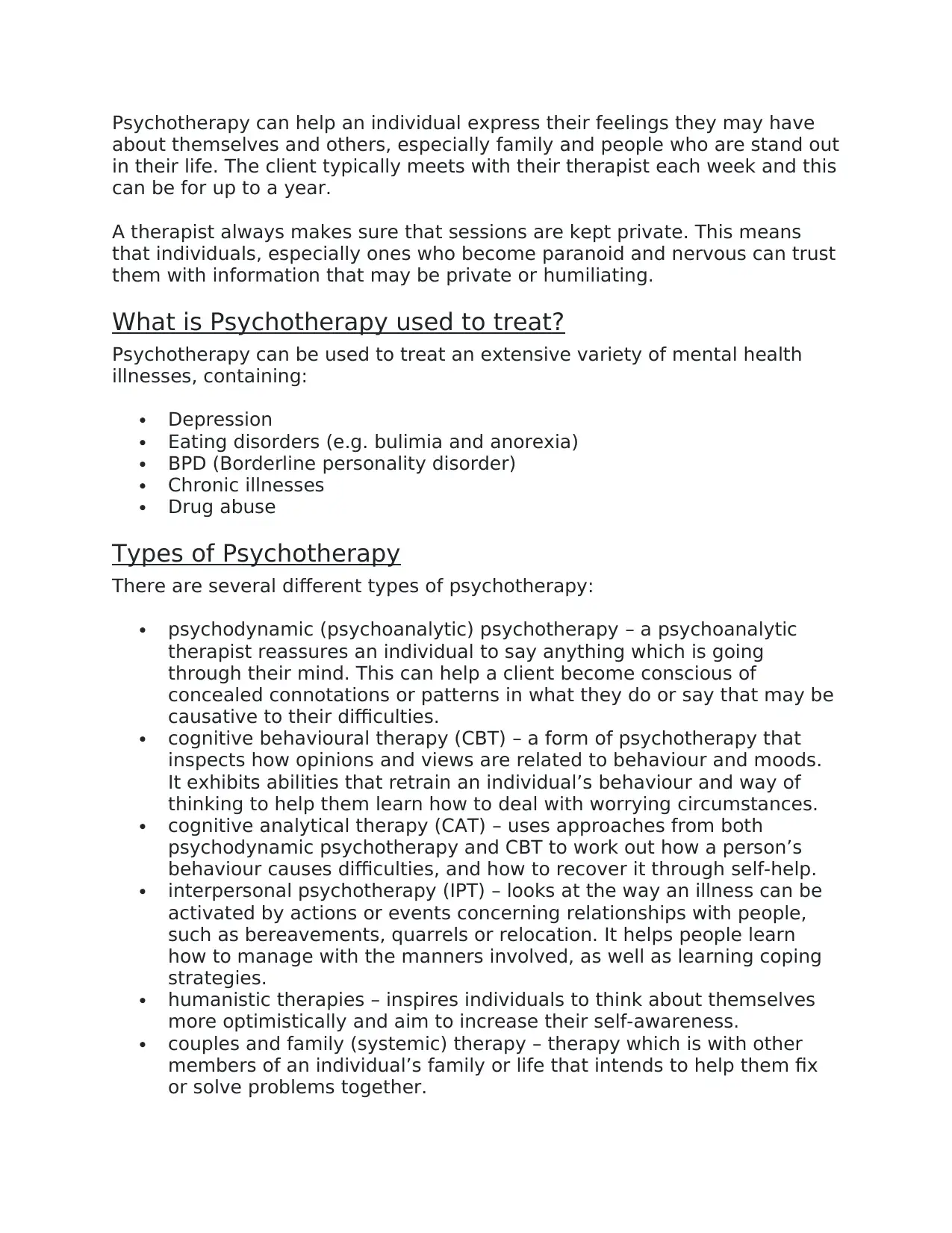
Psychotherapy can help an individual express their feelings they may have
about themselves and others, especially family and people who are stand out
in their life. The client typically meets with their therapist each week and this
can be for up to a year.
A therapist always makes sure that sessions are kept private. This means
that individuals, especially ones who become paranoid and nervous can trust
them with information that may be private or humiliating.
What is Psychotherapy used to treat?
Psychotherapy can be used to treat an extensive variety of mental health
illnesses, containing:
Depression
Eating disorders (e.g. bulimia and anorexia)
BPD (Borderline personality disorder)
Chronic illnesses
Drug abuse
Types of Psychotherapy
There are several different types of psychotherapy:
psychodynamic (psychoanalytic) psychotherapy – a psychoanalytic
therapist reassures an individual to say anything which is going
through their mind. This can help a client become conscious of
concealed connotations or patterns in what they do or say that may be
causative to their difficulties.
cognitive behavioural therapy (CBT) – a form of psychotherapy that
inspects how opinions and views are related to behaviour and moods.
It exhibits abilities that retrain an individual’s behaviour and way of
thinking to help them learn how to deal with worrying circumstances.
cognitive analytical therapy (CAT) – uses approaches from both
psychodynamic psychotherapy and CBT to work out how a person’s
behaviour causes difficulties, and how to recover it through self-help.
interpersonal psychotherapy (IPT) – looks at the way an illness can be
activated by actions or events concerning relationships with people,
such as bereavements, quarrels or relocation. It helps people learn
how to manage with the manners involved, as well as learning coping
strategies.
humanistic therapies – inspires individuals to think about themselves
more optimistically and aim to increase their self-awareness.
couples and family (systemic) therapy – therapy which is with other
members of an individual’s family or life that intends to help them fix
or solve problems together.
about themselves and others, especially family and people who are stand out
in their life. The client typically meets with their therapist each week and this
can be for up to a year.
A therapist always makes sure that sessions are kept private. This means
that individuals, especially ones who become paranoid and nervous can trust
them with information that may be private or humiliating.
What is Psychotherapy used to treat?
Psychotherapy can be used to treat an extensive variety of mental health
illnesses, containing:
Depression
Eating disorders (e.g. bulimia and anorexia)
BPD (Borderline personality disorder)
Chronic illnesses
Drug abuse
Types of Psychotherapy
There are several different types of psychotherapy:
psychodynamic (psychoanalytic) psychotherapy – a psychoanalytic
therapist reassures an individual to say anything which is going
through their mind. This can help a client become conscious of
concealed connotations or patterns in what they do or say that may be
causative to their difficulties.
cognitive behavioural therapy (CBT) – a form of psychotherapy that
inspects how opinions and views are related to behaviour and moods.
It exhibits abilities that retrain an individual’s behaviour and way of
thinking to help them learn how to deal with worrying circumstances.
cognitive analytical therapy (CAT) – uses approaches from both
psychodynamic psychotherapy and CBT to work out how a person’s
behaviour causes difficulties, and how to recover it through self-help.
interpersonal psychotherapy (IPT) – looks at the way an illness can be
activated by actions or events concerning relationships with people,
such as bereavements, quarrels or relocation. It helps people learn
how to manage with the manners involved, as well as learning coping
strategies.
humanistic therapies – inspires individuals to think about themselves
more optimistically and aim to increase their self-awareness.
couples and family (systemic) therapy – therapy which is with other
members of an individual’s family or life that intends to help them fix
or solve problems together.
⊘ This is a preview!⊘
Do you want full access?
Subscribe today to unlock all pages.

Trusted by 1+ million students worldwide
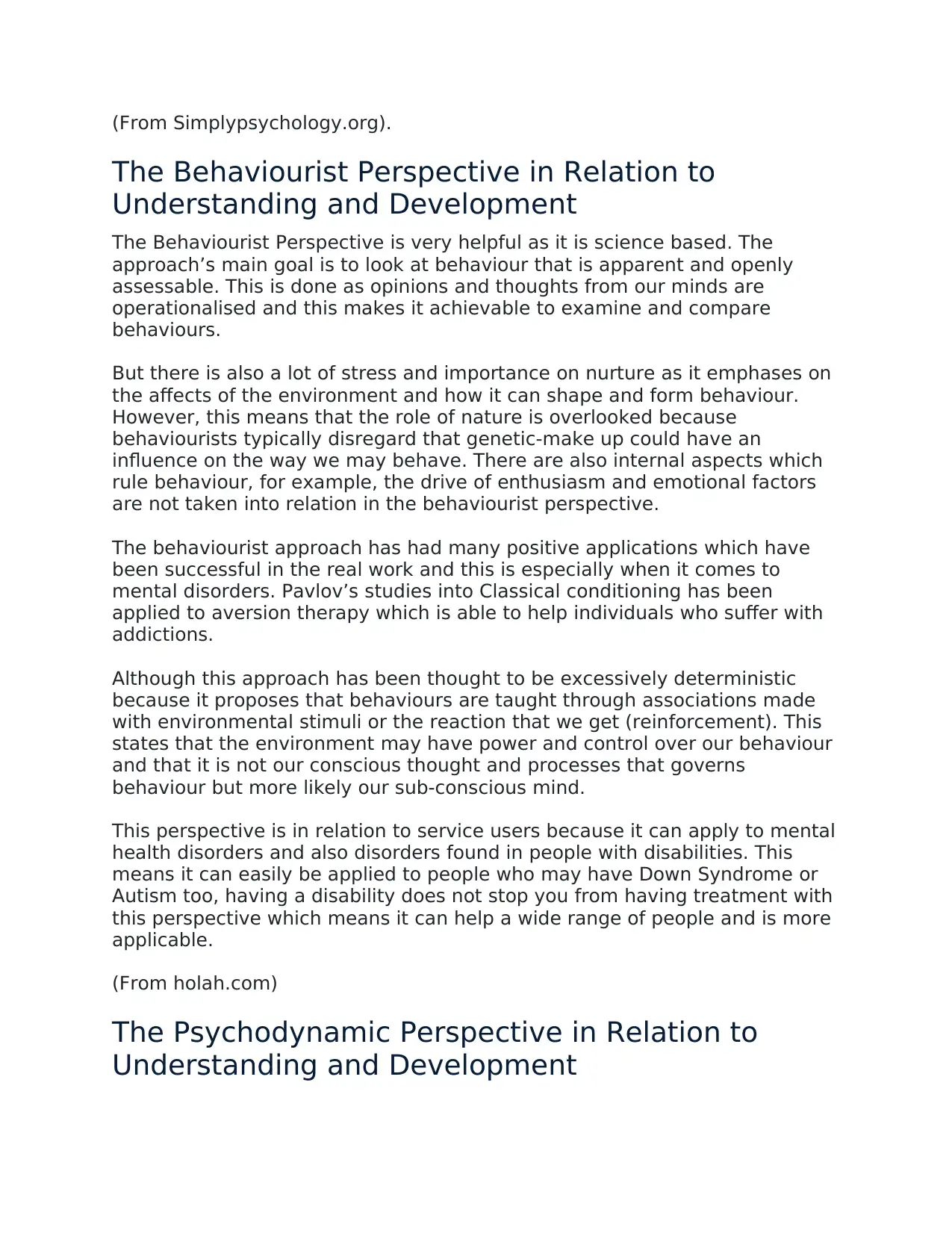
(From Simplypsychology.org).
The Behaviourist Perspective in Relation to
Understanding and Development
The Behaviourist Perspective is very helpful as it is science based. The
approach’s main goal is to look at behaviour that is apparent and openly
assessable. This is done as opinions and thoughts from our minds are
operationalised and this makes it achievable to examine and compare
behaviours.
But there is also a lot of stress and importance on nurture as it emphases on
the affects of the environment and how it can shape and form behaviour.
However, this means that the role of nature is overlooked because
behaviourists typically disregard that genetic-make up could have an
influence on the way we may behave. There are also internal aspects which
rule behaviour, for example, the drive of enthusiasm and emotional factors
are not taken into relation in the behaviourist perspective.
The behaviourist approach has had many positive applications which have
been successful in the real work and this is especially when it comes to
mental disorders. Pavlov’s studies into Classical conditioning has been
applied to aversion therapy which is able to help individuals who suffer with
addictions.
Although this approach has been thought to be excessively deterministic
because it proposes that behaviours are taught through associations made
with environmental stimuli or the reaction that we get (reinforcement). This
states that the environment may have power and control over our behaviour
and that it is not our conscious thought and processes that governs
behaviour but more likely our sub-conscious mind.
This perspective is in relation to service users because it can apply to mental
health disorders and also disorders found in people with disabilities. This
means it can easily be applied to people who may have Down Syndrome or
Autism too, having a disability does not stop you from having treatment with
this perspective which means it can help a wide range of people and is more
applicable.
(From holah.com)
The Psychodynamic Perspective in Relation to
Understanding and Development
The Behaviourist Perspective in Relation to
Understanding and Development
The Behaviourist Perspective is very helpful as it is science based. The
approach’s main goal is to look at behaviour that is apparent and openly
assessable. This is done as opinions and thoughts from our minds are
operationalised and this makes it achievable to examine and compare
behaviours.
But there is also a lot of stress and importance on nurture as it emphases on
the affects of the environment and how it can shape and form behaviour.
However, this means that the role of nature is overlooked because
behaviourists typically disregard that genetic-make up could have an
influence on the way we may behave. There are also internal aspects which
rule behaviour, for example, the drive of enthusiasm and emotional factors
are not taken into relation in the behaviourist perspective.
The behaviourist approach has had many positive applications which have
been successful in the real work and this is especially when it comes to
mental disorders. Pavlov’s studies into Classical conditioning has been
applied to aversion therapy which is able to help individuals who suffer with
addictions.
Although this approach has been thought to be excessively deterministic
because it proposes that behaviours are taught through associations made
with environmental stimuli or the reaction that we get (reinforcement). This
states that the environment may have power and control over our behaviour
and that it is not our conscious thought and processes that governs
behaviour but more likely our sub-conscious mind.
This perspective is in relation to service users because it can apply to mental
health disorders and also disorders found in people with disabilities. This
means it can easily be applied to people who may have Down Syndrome or
Autism too, having a disability does not stop you from having treatment with
this perspective which means it can help a wide range of people and is more
applicable.
(From holah.com)
The Psychodynamic Perspective in Relation to
Understanding and Development
Paraphrase This Document
Need a fresh take? Get an instant paraphrase of this document with our AI Paraphraser
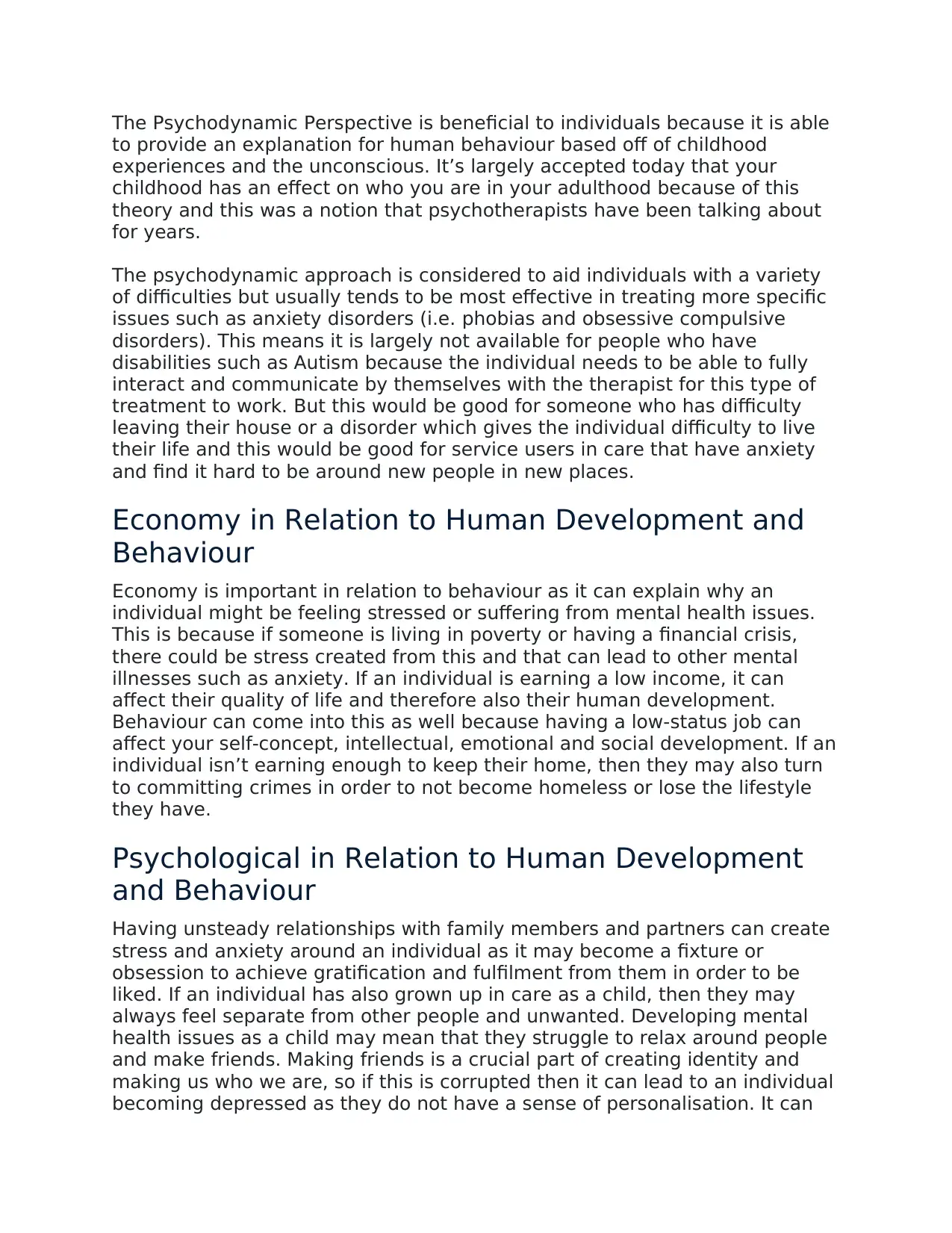
The Psychodynamic Perspective is beneficial to individuals because it is able
to provide an explanation for human behaviour based off of childhood
experiences and the unconscious. It’s largely accepted today that your
childhood has an effect on who you are in your adulthood because of this
theory and this was a notion that psychotherapists have been talking about
for years.
The psychodynamic approach is considered to aid individuals with a variety
of difficulties but usually tends to be most effective in treating more specific
issues such as anxiety disorders (i.e. phobias and obsessive compulsive
disorders). This means it is largely not available for people who have
disabilities such as Autism because the individual needs to be able to fully
interact and communicate by themselves with the therapist for this type of
treatment to work. But this would be good for someone who has difficulty
leaving their house or a disorder which gives the individual difficulty to live
their life and this would be good for service users in care that have anxiety
and find it hard to be around new people in new places.
Economy in Relation to Human Development and
Behaviour
Economy is important in relation to behaviour as it can explain why an
individual might be feeling stressed or suffering from mental health issues.
This is because if someone is living in poverty or having a financial crisis,
there could be stress created from this and that can lead to other mental
illnesses such as anxiety. If an individual is earning a low income, it can
affect their quality of life and therefore also their human development.
Behaviour can come into this as well because having a low-status job can
affect your self-concept, intellectual, emotional and social development. If an
individual isn’t earning enough to keep their home, then they may also turn
to committing crimes in order to not become homeless or lose the lifestyle
they have.
Psychological in Relation to Human Development
and Behaviour
Having unsteady relationships with family members and partners can create
stress and anxiety around an individual as it may become a fixture or
obsession to achieve gratification and fulfilment from them in order to be
liked. If an individual has also grown up in care as a child, then they may
always feel separate from other people and unwanted. Developing mental
health issues as a child may mean that they struggle to relax around people
and make friends. Making friends is a crucial part of creating identity and
making us who we are, so if this is corrupted then it can lead to an individual
becoming depressed as they do not have a sense of personalisation. It can
to provide an explanation for human behaviour based off of childhood
experiences and the unconscious. It’s largely accepted today that your
childhood has an effect on who you are in your adulthood because of this
theory and this was a notion that psychotherapists have been talking about
for years.
The psychodynamic approach is considered to aid individuals with a variety
of difficulties but usually tends to be most effective in treating more specific
issues such as anxiety disorders (i.e. phobias and obsessive compulsive
disorders). This means it is largely not available for people who have
disabilities such as Autism because the individual needs to be able to fully
interact and communicate by themselves with the therapist for this type of
treatment to work. But this would be good for someone who has difficulty
leaving their house or a disorder which gives the individual difficulty to live
their life and this would be good for service users in care that have anxiety
and find it hard to be around new people in new places.
Economy in Relation to Human Development and
Behaviour
Economy is important in relation to behaviour as it can explain why an
individual might be feeling stressed or suffering from mental health issues.
This is because if someone is living in poverty or having a financial crisis,
there could be stress created from this and that can lead to other mental
illnesses such as anxiety. If an individual is earning a low income, it can
affect their quality of life and therefore also their human development.
Behaviour can come into this as well because having a low-status job can
affect your self-concept, intellectual, emotional and social development. If an
individual isn’t earning enough to keep their home, then they may also turn
to committing crimes in order to not become homeless or lose the lifestyle
they have.
Psychological in Relation to Human Development
and Behaviour
Having unsteady relationships with family members and partners can create
stress and anxiety around an individual as it may become a fixture or
obsession to achieve gratification and fulfilment from them in order to be
liked. If an individual has also grown up in care as a child, then they may
always feel separate from other people and unwanted. Developing mental
health issues as a child may mean that they struggle to relax around people
and make friends. Making friends is a crucial part of creating identity and
making us who we are, so if this is corrupted then it can lead to an individual
becoming depressed as they do not have a sense of personalisation. It can
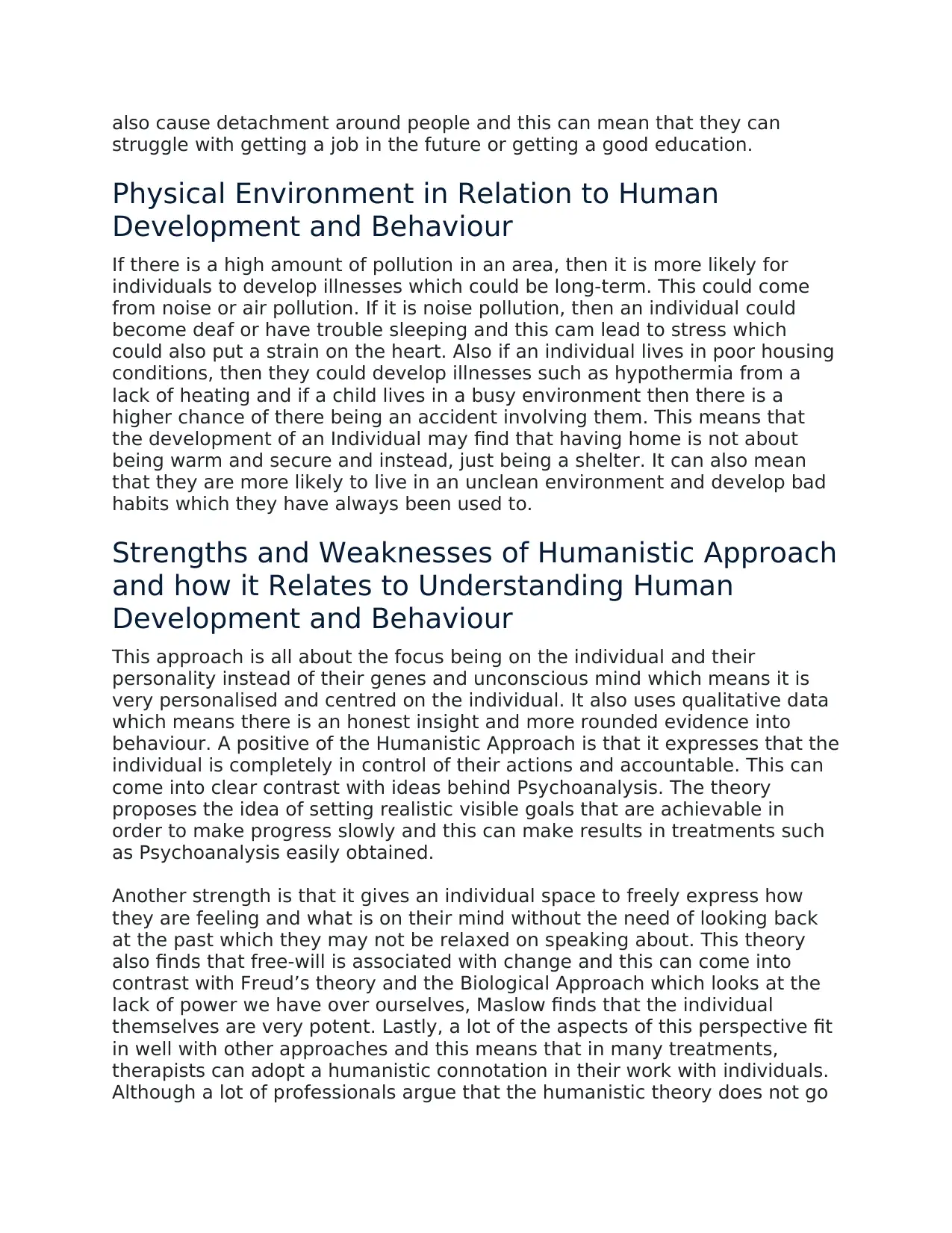
also cause detachment around people and this can mean that they can
struggle with getting a job in the future or getting a good education.
Physical Environment in Relation to Human
Development and Behaviour
If there is a high amount of pollution in an area, then it is more likely for
individuals to develop illnesses which could be long-term. This could come
from noise or air pollution. If it is noise pollution, then an individual could
become deaf or have trouble sleeping and this cam lead to stress which
could also put a strain on the heart. Also if an individual lives in poor housing
conditions, then they could develop illnesses such as hypothermia from a
lack of heating and if a child lives in a busy environment then there is a
higher chance of there being an accident involving them. This means that
the development of an Individual may find that having home is not about
being warm and secure and instead, just being a shelter. It can also mean
that they are more likely to live in an unclean environment and develop bad
habits which they have always been used to.
Strengths and Weaknesses of Humanistic Approach
and how it Relates to Understanding Human
Development and Behaviour
This approach is all about the focus being on the individual and their
personality instead of their genes and unconscious mind which means it is
very personalised and centred on the individual. It also uses qualitative data
which means there is an honest insight and more rounded evidence into
behaviour. A positive of the Humanistic Approach is that it expresses that the
individual is completely in control of their actions and accountable. This can
come into clear contrast with ideas behind Psychoanalysis. The theory
proposes the idea of setting realistic visible goals that are achievable in
order to make progress slowly and this can make results in treatments such
as Psychoanalysis easily obtained.
Another strength is that it gives an individual space to freely express how
they are feeling and what is on their mind without the need of looking back
at the past which they may not be relaxed on speaking about. This theory
also finds that free-will is associated with change and this can come into
contrast with Freud’s theory and the Biological Approach which looks at the
lack of power we have over ourselves, Maslow finds that the individual
themselves are very potent. Lastly, a lot of the aspects of this perspective fit
in well with other approaches and this means that in many treatments,
therapists can adopt a humanistic connotation in their work with individuals.
Although a lot of professionals argue that the humanistic theory does not go
struggle with getting a job in the future or getting a good education.
Physical Environment in Relation to Human
Development and Behaviour
If there is a high amount of pollution in an area, then it is more likely for
individuals to develop illnesses which could be long-term. This could come
from noise or air pollution. If it is noise pollution, then an individual could
become deaf or have trouble sleeping and this cam lead to stress which
could also put a strain on the heart. Also if an individual lives in poor housing
conditions, then they could develop illnesses such as hypothermia from a
lack of heating and if a child lives in a busy environment then there is a
higher chance of there being an accident involving them. This means that
the development of an Individual may find that having home is not about
being warm and secure and instead, just being a shelter. It can also mean
that they are more likely to live in an unclean environment and develop bad
habits which they have always been used to.
Strengths and Weaknesses of Humanistic Approach
and how it Relates to Understanding Human
Development and Behaviour
This approach is all about the focus being on the individual and their
personality instead of their genes and unconscious mind which means it is
very personalised and centred on the individual. It also uses qualitative data
which means there is an honest insight and more rounded evidence into
behaviour. A positive of the Humanistic Approach is that it expresses that the
individual is completely in control of their actions and accountable. This can
come into clear contrast with ideas behind Psychoanalysis. The theory
proposes the idea of setting realistic visible goals that are achievable in
order to make progress slowly and this can make results in treatments such
as Psychoanalysis easily obtained.
Another strength is that it gives an individual space to freely express how
they are feeling and what is on their mind without the need of looking back
at the past which they may not be relaxed on speaking about. This theory
also finds that free-will is associated with change and this can come into
contrast with Freud’s theory and the Biological Approach which looks at the
lack of power we have over ourselves, Maslow finds that the individual
themselves are very potent. Lastly, a lot of the aspects of this perspective fit
in well with other approaches and this means that in many treatments,
therapists can adopt a humanistic connotation in their work with individuals.
Although a lot of professionals argue that the humanistic theory does not go
⊘ This is a preview!⊘
Do you want full access?
Subscribe today to unlock all pages.

Trusted by 1+ million students worldwide
1 out of 14
Related Documents
Your All-in-One AI-Powered Toolkit for Academic Success.
+13062052269
info@desklib.com
Available 24*7 on WhatsApp / Email
![[object Object]](/_next/static/media/star-bottom.7253800d.svg)
Unlock your academic potential
Copyright © 2020–2025 A2Z Services. All Rights Reserved. Developed and managed by ZUCOL.




